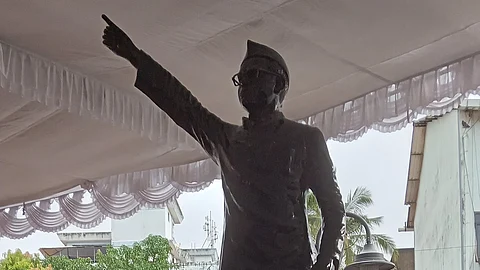

In the heart of Panjim lies 18th June Road — one of Goa’s most iconic shopping streets, bustling with tourists and locals alike. But behind its lively facade lies a powerful legacy. This road is named after one of the most significant dates in Goa’s history: June 18th, Goa Revolution Day — a day that marks the beginning of the state’s struggle for liberation from Portuguese rule.
The importance of this day can be traced back to June 18, 1946, in Margão, when Dr Ram Manohar Lohia and Dr Julião Menezes led a civil disobedience movement against the oppressive regime of Portuguese dictator Salazar. Their bold action ignited a revolution that would culminate in Goa’s eventual liberation on December 19, 1961.
The Torchbearers of Goa’s Freedom Movement
Dr Ram Manohar Lohia, though not a Goan by birth, became an integral part of Goa’s freedom struggle. Born on March 23, 1910, in Akbarpur, Uttar Pradesh, Lohia was a brilliant scholar. After studying in Mumbai, Varanasi, and Kolkata, he pursued a doctorate in National Economy at Frederick William University (now Humboldt University) in Berlin from 1929 to 1933. A passionate socialist and freedom fighter, he was actively involved in India’s independence movement and played a key role in operating the covert "Congress Radio" during British rule.
It was during his time in Berlin that he met Dr Julião Menezes, a Goan from Assolna who had also gone to Berlin to study medicine. The friendship between these two men would later lay the foundation for Goa’s fight for freedom.
Dr Julião Menezes, often the lesser-known hero of Goa’s liberation, was a committed nationalist and rationalist. Upon returning to Goa, he tried to introduce progressive thinking through the Clube de Assolna but met with resistance from the conservative society. He later moved to Bombay in 1939, where he founded the Gomantak Praja Mandal and launched a bilingual weekly newspaper, Gomantak, in 1942 to promote nationalist ideas in Konkani and English.
Despite the distance, Menezes and Lohia remained in close contact. In 1946, Dr Menezes invited Lohia to Goa to recuperate after a medical examination. During that visit, the two men deliberated over Goa’s political climate and decided it was time to act. Their decision sparked the civil disobedience movement on June 18, 1946 — a turning point that galvanized Goans into action and ultimately led to liberation 15 years later.
More Than Just a Date
Today, 18th June is not just a day on the calendar — it is a symbol of courage and resistance. The road that bears its name in Panjim serves as a daily reminder of the sacrifices made and the vision of two men who dared to challenge colonial rule.
As Goa commemorates Revolution Day, it’s worth remembering that freedom was not gifted — it was fought for, with determination, vision, and unwavering courage. Thanks to Dr Ram Manohar Lohia and Dr Julião Menezes, Goans today can walk freely on roads once paved with resistance.